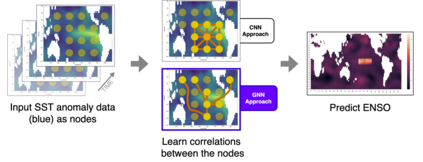Deep learning-based models have recently outperformed state-of-the-art seasonal forecasting models, such as for predicting El Ni\~no-Southern Oscillation (ENSO). However, current deep learning models are based on convolutional neural networks which are difficult to interpret and can fail to model large-scale atmospheric patterns called teleconnections. Hence, we propose the application of spatiotemporal Graph Neural Networks (GNN) to forecast ENSO at long lead times, finer granularity and improved predictive skill than current state-of-the-art methods. The explicit modeling of information flow via edges may also allow for more interpretable forecasts. Preliminary results are promising and outperform state-of-the art systems for projections 1 and 3 months ahead.
翻译:深层次的学习模型最近比预测厄尔尼诺-南方涛动(ENSO)等最先进的季节性预测模型效绩要强,但是,目前的深层次学习模型是以难以解释的进化神经网络为基础的,可能无法模拟称为远程连接的大规模大气模式,因此,我们提议在较长的周转时间、比目前最先进的方法更精细的颗粒性以及更好的预测技能上应用超模时时速图像神经网络(GNN)来预测厄尔尼诺/南方涛动(ENSO),而通过边缘进行信息流动的明确模型也可以进行更多的可解释的预测。初步结果对未来1个月和3个月预测来说是充满希望的,并且超越了最先进的艺术系统。






